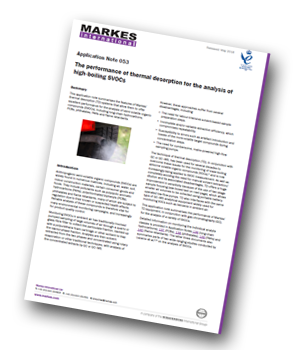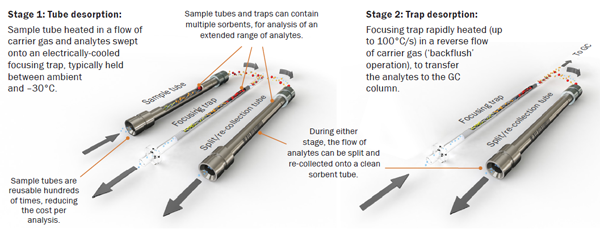This application note summarises the features of Markes’ thermal desorption (TD) systems that allow them to offer excellent performance for the analysis of semi-volatile organic compounds (SVOCs), including long-chain hydrocarbons, PCBs, phthalates, PAHs and flame retardants.
 Introduction
Introduction
Anthropogenic SVOCs are widely found in numerous matrices, including air, water, soil, indoor construction materials, certain consumer goods and foods. They include pollutants such as polycyclic aromatic hydrocarbons (PAHs), polychlorinated biphenyls (PCBs), phthalates and flame retardants, many of which are subject to regulation due to their known or suspected health effects. Reliable analysis of these compounds is therefore vital for many environmental monitoring campaigns, and increasingly for product quality control.
Monitoring SVOCs in ambient air has traditionally involved pumped sampling of large volumes of air through a quartz or glass fibre filter to collect the particulate fraction, backed-up with a polyurethane foam cartridge or other sorbent to trap the vapour-phase fraction. Analytes are then solvent extracted from the two phases and concentrated using rotary evaporation or other traditional techniques, with analysis of the concentrated extracts by GC or GC–MS. However, these approaches suffer from several disadvantages that are explained in the application note.
The technique of thermal desorption (TD), in conjunction with GC or GC–MS, has been used for several decades to overcome these issues for the monitoring of lower-boiling airborne volatile organic compounds (VOCs), and is now increasingly being applied to SVOC measurement. As well as completely avoiding the need for manual solvent extraction/dilution and its associated disadvantages, TD offers a huge improvement in sensitivity because of the use of two-stage sample focusing (see below), which allows smaller air volumes to be collected using portable battery operated low-flow pumps. TD also interfaces with the same type of GC–MS analytical equipment widely used for monitoring VOCs such as benzene in ambient air.

This application note summarises the performance of Markes’ TD equipment, in conjunction with gas chromatography (GC), for the analysis of a variety of SVOCs.
Conclusions
This overview demonstrates the outstanding performance that Markes’ TD systems provide for a range of SVOCs. Key results include negligible carryover even for the highest boiling compounds, excellent response reproducibilities and high re-collection efficiencies. Such performance translates to excellent linearities across a wide concentration range and low limits of detection in real sampling scenarios.




